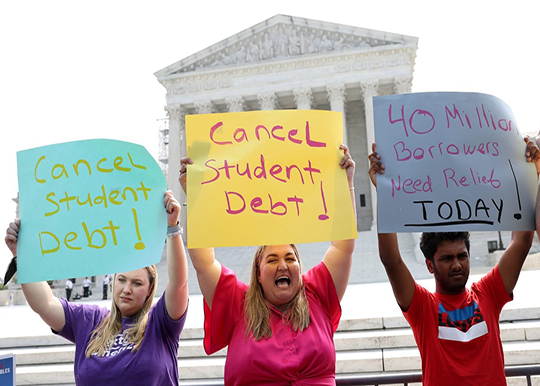Supreme Court Strikes Down Student Debt Cancellation. Now What?

The Supreme Court has blocked President Joe Biden’s student loan debt relief plan, saying his administration lacked authorization under the HEROES Act to forgive up to $20,000 in student debt per borrower.
Some 43 million borrowers won’t see a cent of the debt cancellation promised by the White House last year. Under current guidance from the Education Department, borrowers must get ready to resume student loan payments starting in October on their full student loan balance.
The White House has not yet said it will pursue cancellation via another legal route, but activists are calling on Biden to pursue a plan B. On Friday afternoon, Biden’s official Twitter account called the ruling “unthinkable” and said he would have more to say later in the day. But a Plan B is far from guaranteed, and there is no timeline yet. Take steps to prepare for repayment now.
“Now that we have the decision, we can move forward,” says Betsy Mayotte, president and founder of The Institute of Student Loan Advisors. “There are a lot of borrowers who have been in limbo waiting to see what was going to happen.”
What did the Supreme Court decide?
The court ruled in two cases, and struck down the cancellation through the second case. All nine justices unanimously dismissed the first case, Department of Education v. Brown, because they found the plaintiffs had no standing to sue since they “fail to establish that any injury they suffer from not having their loans forgiven is fairly traceable to the Plan.” The two plaintiffs — individuals who claim they weren’t eligible for part or all of the relief — said they were harmed by not having the opportunity to participate in a notice-and-comment period for the program.
In the second case, Biden v. Nebraska, the court found that at least one plaintiff, the state of Missouri, had the right to sue. Six states sued jointly — Arkansas, Iowa, Kansas, Missouri, Nebraska and South Carolina — alleging the relief would harm tax revenue in those states in addition to the finances of certain state-based loan agencies.
With standing established, a 6-3 majority of justices declared that Biden’s student debt cancellation plan, enacted under the 2003 HEROES Act, was unconstitutional. Chief Justice John Roberts delivered the opinion of the court, joined by Justices Clarence Thomas, Samuel Alito, Brett Kavanaugh and Amy Coney Barrett.
“The Secretary asserts that the HEROES Act grants him the authority to cancel $430 billion of student loan principal. It does not,” wrote Chief Justice John Roberts in the majority opinion. “We hold today that the Act allows the Secretary to ‘waive or modify’ existing statutory or regulatory provisions applicable to financial assistance programs under the Education Act, not to rewrite that statute from the ground up.”
Justice Elena Kagan penned the dissent, joined by fellow liberal justices Sonia Sotomayor and Ketanji Brown Jackson.
How did we get here and what’s next?
President Joe Biden’s student debt cancellation plan, first unveiled in August 2022, promised to erase up to $10,000 per individual borrower earning less than $125,000 annually or per married couple earning less than $250,000, and up to $20,000 for those who received a need-based Pell Grant while in college. The White House said that 90% of the relief would go to borrowers earning less than $75,000 per year.
Roughly 26 million borrowers applied or were automatically eligible for relief — and 16 million of them were approved by the Education Department and subsequently sent to loan servicers. The White House opened debt relief applications in October but closed them a month later as lawsuits swirled. The Supreme Court soon agreed to take on two of the lawsuits and held oral arguments for student debt cancellation on Feb. 28.
If you were among the millions of borrowers counting on this relief, you still have options to lower your monthly payments and even get some of your debt forgiven. Here’s what else borrowers need to know, and how to prepare for the impending end of forbearance.
What should I do now?
Get ready to make payments
Federal student loan payments are set to resume soon, with no possibility of further forbearance extensions. Interest will start accruing again on Sept. 1, and borrowers will have to resume monthly payments on their full student loan balance starting in October.
“Take your time, get very organized, identify where your loans are, what your repayment expectations are, sit down and actually create your own budget or spending plan,” says Stacey MacPhetres, senior director of education finance at education and child care company Bright Horizons. “And then take the time to figure out what you need to do.”
If you set money aside during the payment pause, consider making a lump sum student loan payment toward your balance before Sept. 1 to avoid racking up interest.
Find your servicer and set up payments
Check to see who your servicer is. Roughly 44% of borrowers now have a different federal student loan servicer than before the pandemic, according to the Consumer Financial Protection Bureau. You can identify your servicer by logging into your studentaid.gov account with your FSA ID or calling the Federal Student Aid Information Center at 800-433-3243.
Your servicer can help you do the following:
- Check that your contact information is up to date.
- Determine the amount you owe, the size of your monthly payments and when your first bill will be due.
- Set up auto-pay. If you had this set up before forbearance, you’ll need to sign up again.
- Discuss student loan repayment plan options to potentially lower your monthly bills.
Expect long wait times when calling your servicer, cautions Scott Buchanan, executive director of the Student Loan Servicing Alliance. You may also be able to check some of this information on your servicer’s self-service online portal to avoid the customer service bottleneck.
Ask about income-driven repayment plans
If you anticipate not being able to make your student loan payment, your servicer can set you up with different payment plans and relief options. Consider asking about income-driven repayment (IDR) plans, which cap monthly bills at a set percentage of your income and erase remaining student debt after you make payments for a set number of years. If you earn below a certain income threshold or have lost your job entirely, you could pay as little as $0 per month under an IDR plan.
And a new IDR plan is in the pipeline that could cut monthly payments in half for most borrowers with undergraduate loans, and fast-track some with lower balances to forgiveness.
“I don’t know whether that plan will be ready to go in the fall,” Mayotte says. “But I know that there is a strong desire by the administration to get that plan, whatever it looks like, up and running sooner rather than later.”
If your student loans are in default
A temporary government program called Fresh Start could help if you had student loans in default before the payment pause. The program gives these borrowers the opportunity to re-enter repayment in good standing and access IDR plans and other relief.
Though borrowers will have one year to enroll in the Fresh Start program once forbearance officially ends this fall, they should apply as soon as possible, advises Michele Shepard, senior director of college affordability at The Institute for College Access & Success. The application is already open. You can sign up for the Fresh Start program today by going to myeddebt.ed.gov and logging in to your account, or calling the Federal Student Aid Office at 1-800-621-3115.
What if I can’t repay my student loans?
Contact your servicer before you miss a payment. Ask about your options to lower or temporarily suspend payments through student loan deferment or forbearance. Start with an IDR plan, which sets payments at a portion of your income and extends your repayment term. These options can help keep you out of student loan delinquency (when a payment is late by as little as one day) and default (when a payment is at least 270 days late).
Don’t skip student loan payments. Defaulting on your loans can set off a devastating cascade of financial consequences, says Kristen Ahlenius, director of education at workplace financial wellness company Your Money Line. This can include credit score hits, seized paychecks and more.
Other ways to get help
Some nonprofit and legal organizations can offer student loan help as you navigate a return to payments. But be aware of scams, and avoid debt relief companies and anyone offering loan forgiveness. Only the government can forgive your student loans.
“It feels like there’s a lot of fervor and panic right now,” MacPhetres says. “But there’s time, there’s opportunity, lots of repayment options and the servicers are there to help.”


